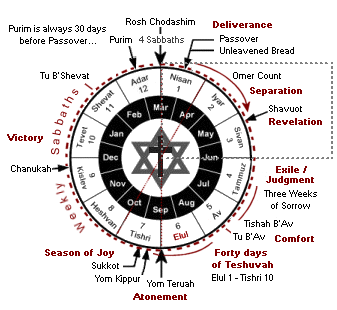|
|
|||||||||||||||||||||
 |
|||||||||||||||||||||
|
Learn Hebrew |
|||||||||||||||||||||
|
|
|
||||||||||||||||||||||||||||||||
|
The second month of the traditional Jewish calendar (as reckoned from the month of Nisan) is called Iyyar (ūÉų┤ūÖų╝ųĖūÖū©). In the Torah, this month is simply called "the second month" (i.e., chodesh sheni: ūŚūōųČū®ūü ūöųĘū®ų╝ūüųĄūĀų┤ūÖ), though later it was called Ziv (ū¢ų┤ūĢ), a Canaanite loan word that means "glow" or "blossom," perhaps suggesting the growing season of early spring (1 Kings 6:1). The word Ziv may be related to the word zuv (ū¢ūĢų╝ūæ), meaning a flow or gush of fluid. Like most other Hebrew months, the name was later changed some time after the Babylonian captivity. Iyyar usually falls in AprilŌĆōMay on the Gregorian calendar. The month always lasts 29 days and Rosh Chodesh is therefore observed for two days (i.e., the last day of Nisan and the first day of the new month). It was during this month that those who were unable to observe Passover were allowed to celebrate a "second Passover" exactly 30 days later, on Iyyar 14-15 (Num. 9:9-12). Recall that exactly one month after the Exodus (i.e., Iyyar 15) God led the Israelites from the oasis and palm trees at Elim into the deeper part of the desert, to midbar Sin (ū×ų┤ūōų░ūæų╝ųĘū©ųŠūĪų┤ūÖū¤), a desolate region that was about midway to Sinai going southeast (Exod. 16:1). About this time, the food provisions the people had brought with them ran out, and the Israelites began grumbling against Moses and Aaron, saying: "If only we had died by the hand of God in the land of Egypt, when we sat by the pots of meat, when we ate bread to our fill, for you have brought us out into this desert to starve to death!" (Exod. 16:3). God then said to Moses, "'Look I am going to rain down bread from heaven (ū£ųČūŚųČūØ ū×ų┤ū¤ųŠūöųĘū®ų╝ūüųĖū×ųĖūÖų┤ūØ) for you. The people will go out and gather a portion for that day so that I might test whether they will walk in my Torah (ū¬ų╝ūĢų╣ū©ųĖūö) or not" (Exod. 16:4). Each Friday the people received a double portion that was to last them through Shabbat, and the test centered on whether the people would refrain from seeking manna on God's appointed day of rest. Note that the Ten Commandments had not yet been given to Israel at this time, so it is likely that the law of manna was meant to prepare them for the law of the Sabbath that would be given at Sinai the following month (i.e., on Sivan 6, or Shavuot). According to Jewish tradition, it was also during the month of Iyyar that the "Well of Miriam" began to flow (zuv) to provide fresh water for the people. The war with Amalek - Israel's first national enemy - also took place during the month of Iyyar just before the revelation was given at Sinai.
This was prophetic, of course, since the Scriptures later reveal that it was during this same month that King Solomon began to build the Holy Temple in Jerusalem (1 Kings 6:1). |
|
Holidays in Iyyar |
|
Finally, the month of Iyyar is important in more recent Jewish history and tradition. On the modern Jewish calendar, a number of newer holidays are observed, including Yom HaZikaron (Iyyar 4), Yom Ha'atzmaut (Iyyar 5), Lag B'Omer (Iyyar 18), and Yom Yerushalayim (Iyyar 28). By far the greatest of these modern holidays is Yom Ha'atzmaut, or Israel's Independence Day, which was originally announced on before sunset on Friday, May 14th (i.e., Iyyar 5, 5708). And of course the liberation of the Temple Mount on June 7th, 1967 (i.e., Iyyar 28, 5727) is also highly prophetic.
|
|
About Jerusalem Day - ūÖūĢūØ ūÖū©ūĢū®ū£ūÖūØ |
|
|
|
Rosh Chodesh Blessing |
|
The following (simplified) blessing can be recited to ask the LORD to help you for the coming new month of Iyyar: |
|
ūÖų░ūöų┤ūÖ ū©ųĖū”ūĢų╣ū¤ ū×ų┤ū£ų╝ų░ūżųĖūĀųĄūÖūÜųĖ ūÖūöūĢūö ūÉų▒ū£ūöųĄūÖūĀūĢų╝ ye┬Ęhee ┬Ę rah┬Ętzon ┬Ę meel┬Ęfah┬Ęne'┬Ękha ┬Ę Adonai ┬Ę e┬Ęloh┬Ęhey'┬Ęnoo "May it be Your will, LORD our God and God of our fathers,
|
|||||||
|
Hebrew for Christians |
|||||||
|
|||||||






